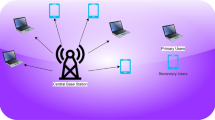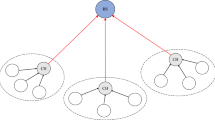Abstract
In cognitive radio ad hoc networks, the nodes exhibit autonomous behavior and selfishly search for the available channels to make spectrum selection decisions. A natural competition among cognitive users arises that may result is chaos and serious degradation in spectrum utilization. In this competitive and hostile environment, game theoretic model can ease this rivalry and autonomously assist in creating a subdued environment. We introduce a repeated game to alleviate the spectrum allocation problem and facilitate the cognitive radio users to make spectrum selection decision simultaneously or asynchronously. In contrast to sequential games, the proposed simultaneous move multi-stage game model is appropriate for practical applications where paucity of central spectrum management resources is common. In order to avoid the conflicts arising from coinciding concurrent decisions, we incorporate learning via history statistics to attain a stable and efficient equilibrium point. Every player computes the feasibility of playing a strategy from the action of the opponents in the previous iterations by incorporating the proposed learning rule. This learning process assists in decision making for the next iteration and the Nash equilibrium is achieved.




Similar content being viewed by others
References
Reed, J. H., Gilles, R. P., & DaSilva, L. A. (2004). Analyzing distributed algorithms assuming deterministic channels. Technical report Virginia Tech.
Gao, R. (2013). Potential game for dynamic spectrum management in cognitive radio networks. Journal of Information and Computational Science, 10(6), 1805–1817.
Tuan, T. A., Tong, L. C., & Premkumar, A. B. (2009). A cooperative temporal spectrum sharing game in cognitive radio network. In Symposium on progress in information and communication technology (pp. 23–28).
Giupponi, L., & Ibars, C. (2009). Distributed cooperation among cognitive radios with complete and incomplete information. EURASIP Journal on Advances in Signal Processing.
Bloem, M., Alpcan, T., & Basar, T. (2007). A Stackelberg game for power control and channel allocation in cognitive radio networks. In Cognitive Radio Networks, ACM Proceedings of the International Conference on Game Theory in Communications Networks (GAMECOMM), Nantes (pp. 1–9).
Nie, N., & Comaniciu, C. (2005). Adaptive channel allocation spectrum etiquette for cognitive radio networks. In Proceedings of IEEE DySPAN (pp. 269–278).
Cremene, L. C., Dumitrescu, D., Nagy, R., & Gasko, N. (2012). Cognitive radio simultaneous spectrum access/one-shot game modelling. In 8th International Symposium on Communication Systems, Networks and Digital Signal Processing (CSNDSP) (pp. 1–6). 978-1-4577-1472-6.
Malekpour, H., & Berangi, R. (2012). Cournot and Bertrand game models for a simple spectrum sharing framework in cognitive radio networks. World of Computer Science and Information Technology Journal (WCSIT). 2221-0741, 2(6), 197–202.
Xu, Y., Anpalagan, A., Wu, Q., Shen, L., Gao, Z., & Wang, J. (2013). Decision-theoretic distributed channel selection for opportunistic spectrum access: Strategies, challenges and solutions. IEEE Communications Surveys and Tutorials, 15(4), 1689–1713.
Xu, Y., Wu, Q., Wang, J., Shen, L., & Anpalagan, A. (2013). Opportunistic spectrum access using partially overlapping channels: Graphical game and uncoupled learning. IEEE Transactions on Communications, 61(9), 3906–3918.
Xu, Y., Wu, Q., Shen, L., Wang, J., & Anpalagan, A. (2013). Opportunistic spectrum access with spatial reuse: Graphical game and uncoupled learning solutions. IEEE Transactions on Wireless Communications, 12(10), 4814–4826.
Xu, Y., Wang, J., Wu, Q., Anpalagan, A., & Yao, Y. (2012). Opportunistic spectrum access in unknown dynamic environment: A game-theoretic stochastic learning solution. IEEE Transactions on Wireless Communications, 11(4), 1380–1391.
Xu, Y., Wang, J., Wu, Q., Anpalagan, A., & Yao, Y. (2012). Opportunistic spectrum access in cognitive radio networks: Global optimization using local interaction games. IEEE Journal of Selected Topics in Signal Processing, 6(2), 180–194.
Freund, Yoav, & Schapire, Robert E. (1997). A decision-theoretic generalization of on-line learning and an application to boosting. Journal of Computer and System Sciences, 55, 119–139.
Chen, L., Iellamo, S., Coupechoux, M., & Godlewski, P. (2011). Spectrum auction with interference constraint for cognitive radio networks with multiple primary and secondary users. Wireless Networks, 17, 13551371.
Li, H., & Han, Z. (2010). Competitive spectrum access in cognitive radio networks: Graphical game and learning. In WCNC 2010 proceedings, IEEE. 978-1-4244-6398-5.
Latifa, B., Gao, Z., & Liu, S. (2012). No-regret learning for simultaneous power control and channel allocation in cognitive radio networks. In Computing, communications and applications conference (ComComAp) (pp. 267–271). ISBN:978-1-4577-1717-8.
Niyato, D., & Hossain, E. (2008). Spectrum trading in cognitive radio networks: A market-equilibrium-based approach. IEEE Wireless Communications, 15(6), 71–81.
Zhu, H., Pandana, C., & Liu, K. J. R. (2007). Distributive opportunistic spectrum access for cognitive radio using correlated equilibrium and no-regret learning. In Wireless communications and networking conference (WCNC) (pp. 11–15).
Feng, W. J., Zhou, C., & Jiang, W. (2012). Dynamic channel allocation based on the game learning in cognitive radio networks. In 12th IEEE international conference on communication technology (ICCT) (pp. 167–170). ISBN: 978-1-4244-6868-3.
Author information
Authors and Affiliations
Corresponding author
Rights and permissions
About this article
Cite this article
Minhas, Q., Mahmood, H. & Malik, H. Channel selection for simultaneous move game in cognitive radio ad hoc networks. Wireless Netw 22, 61–68 (2016). https://doi.org/10.1007/s11276-015-0952-x
Published:
Issue Date:
DOI: https://doi.org/10.1007/s11276-015-0952-x




